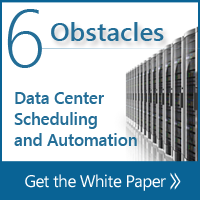Workload Automation Trends Towards Democratization
Workload automation is moving towards democratization, driven in part by self-service automation and an increasing reliance on complicated data.

Fluidity is the new mantra in workload automation. Management demands, data sources, SLA requirements, computing infrastructure— everything attached to IT is turning more flexible, more diverse and more nimble in order to satisfy the accelerating pace of business. At the center of it all, job scheduling and workload automation is becoming more important than at any time in the last 30 years. In the past twelve months we’ve witnessed the continued evolution of business IT into something faster, bigger, and more adaptable than we could have imagined even a few short years ago. Workload automation technology is responding with new solutions that will be increasingly visible in 2013 and beyond. These are the key trends we’ve identified that are re-shaping the segment:
Workload Automation Trends of 2012
SLA-Driven Workload Management
BI has matured IT by setting business policies and requiring SLAs for workloads and runbook automation. As a result, more advanced monitoring and alerting is being developed, as well as critical path analysis tied to business priority. This will be essential in order to ensure that resources are provisioned quickly for high-priority jobs and workflows.
Size, Sources, Complexities of Data are Exploding
Big Data no longer resides only within the enterprise. The democratization of BI is causing the death of the single data warehousing model; organizations are pulling data from multiple third-party sources to integrate with internal stores. Moreover, we’ve also seen a rise in self-serve data marts that enable BI users to choose the data sets needed for specific tasks. The need to automate the integration and movement of data between these disparate sources is creating what many are calling “agile BI,” or the ability to update integration processes quickly and efficiently.
Reducing IT Operation Costs Through Dynamic Provisioning
Cloud computing is transforming just about every facet of enterprise IT. But perhaps the biggest change is its ability to turn data processing infrastructure into a pay-as-you-go proposition, drawing upon resources of virtually limitless size exactly at the time they’re needed. By allowing workload automation to provision resources on demand, whether internal, virtual or cloud-based, IT organizations can ensure that the capacity curve tracks to the workload demand curve. This has the added benefit of effectively eliminating costs associated with idle assets between workload bursts.
2013 Workload Automation Trends
Reactive Automation Model Shifts to Predictive
In response to the diverse array of systems and resources both inside and outside the enterprise, workload automation is becoming “intelligent”; that is, it is combining predictive and reactive forms of resource management in order to not only schedule workflows, but also proactively provision, schedule and distribute the necessary internal, virtual and cloud resources on the fly, all based on historical analysis, to ensure SLAs are being met and bottlenecks eliminated. In particular, new “what-if” capabilities are coming that will enable workflow forecasting across different platforms. IT managers will be able to predict when spikes may overload servers or systems upon which workloads are executing, then distribute those workloads across servers prior to the spike. The improvement will help provide better alignment between IT organizations and the businesses they support.
Democratization of BI Driving the Need for Real-Time Data
Because Business Intelligence is now something used by managers at all levels and in all areas of specialization, there is an increasing need for real-time, or near real-time, data updates to support on-demand decision-making. This is putting huge obligations on workload automation solutions to react quickly by reliably executing the complex workflows needed.
Self-Serve Automation
Managers outside the IT department —those with BI needs— will soon be able to choose from a workload automation service catalog to initiate processes or workflows themselves. Intelligent workload automation will move to support this trend, enabling the system to self-provision the necessary resources and then execute automatically.
Conclusion
Not so long ago, many people thought that job scheduling and workload automation solutions were becoming less relevant as mainframe systems gave way to distributed forms of processing. Nothing could be further from the truth. With IT becoming more complex, diverse and real-time than ever before, coordination and efficiency moves to the forefront. Corporate Web sites, especially transactional eCommerce sites, are just one example of the many mission-critical functions governed by IT. With business processes, applications and computing infrastructures intertwined and interdependent inside and outside the enterprise, small glitches can spiral into major outages. Expect workload automation solutions to become a focal point of IT architecture in order to better manage this fluid new era of 24/7 processing.








